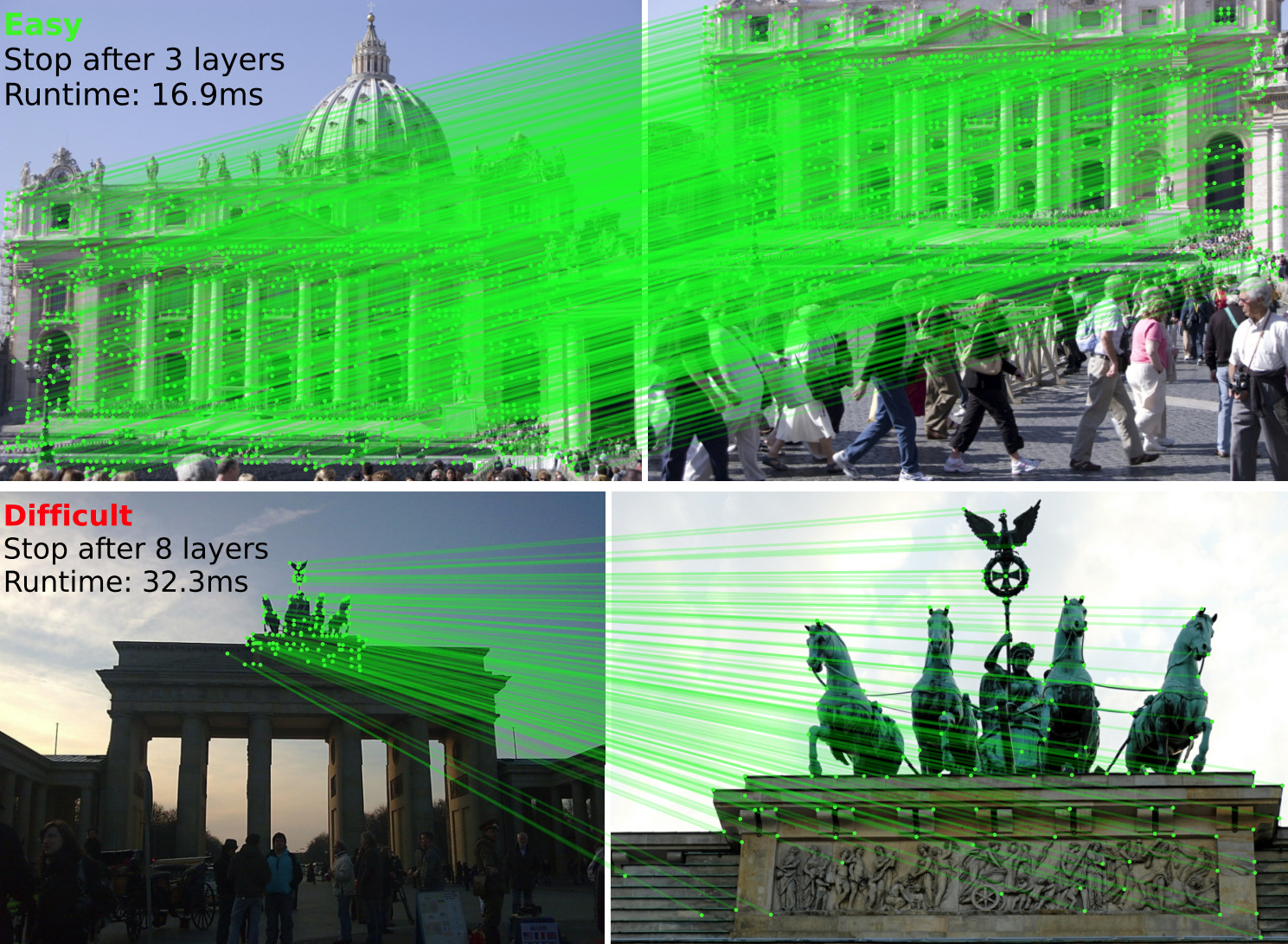LightGlue ⚡️
Local Feature Matching at Light Speed
Philipp Lindenberger
·
Paul-Edouard Sarlin
·
Marc Pollefeys
Paper |
Colab

LightGlue is a deep neural network that matches sparse local features across image pairs.
An adaptive mechanism makes it fast for easy pairs (top) and reduces the computational complexity for difficult ones (bottom).
##
This repository hosts the inference code of LightGlue, a lightweight feature matcher with high accuracy and blazing fast inference. It takes as input a set of keypoints and descriptors for each image and returns the indices of corresponding points. The architecture is based on adaptive pruning techniques, in both network width and depth - [check out the paper for more details](https://arxiv.org/pdf/2306.13643.pdf).
We release pretrained weights of LightGlue with [SuperPoint](https://arxiv.org/abs/1712.07629) and [DISK](https://arxiv.org/abs/2006.13566) local features.
The training end evaluation code will be released in July in a separate repo. To be notified, subscribe to [issue #6](https://github.com/cvg/LightGlue/issues/6).
## Installation and demo [](https://colab.research.google.com/github/cvg/LightGlue/blob/main/demo.ipynb)
Install this repo using pip:
```bash
git clone https://github.com/cvg/LightGlue.git && cd LightGlue
python -m pip install -e .
```
We provide a [demo notebook](demo.ipynb) which shows how to perform feature extraction and matching on an image pair.
Here is a minimal script to match two images:
```python
from lightglue import LightGlue, SuperPoint, DISK
from lightglue.utils import load_image, rbd
# SuperPoint+LightGlue
extractor = SuperPoint(max_num_keypoints=2048).eval().cuda() # load the extractor
matcher = LightGlue(features='superpoint').eval().cuda() # load the matcher
# or DISK+LightGlue
extractor = DISK(max_num_keypoints=2048).eval().cuda() # load the extractor
matcher = LightGlue(features='disk').eval().cuda() # load the matcher
# load each image as a torch.Tensor on GPU with shape (3,H,W), normalized in [0,1]
image0 = load_image('path/to/image_0.jpg').cuda()
image1 = load_image('path/to/image_1.jpg').cuda()
# extract local features
feats0 = extractor.extract(image0) # auto-resize the image, disable with resize=None
feats1 = extractor.extract(image1)
# match the features
matches01 = matcher({'image0': feats0, 'image1': feats1})
feats0, feats1, matches01 = [rbd(x) for x in [feats0, feats1, matches01]] # remove batch dimension
matches = matches01['matches'] # indices with shape (K,2)
points0 = feats0['keypoints'][matches[..., 0]] # coordinates in image #0, shape (K,2)
points1 = feats1['keypoints'][matches[..., 1]] # coordinates in image #1, shape (K,2)
```
We also provide a convenience method to match a pair of images:
```python
from lightglue import match_pair
feats0, feats1, matches01 = match_pair(extractor, matcher, image0, image1)
```
##

LightGlue can adjust its depth (number of layers) and width (number of keypoints) per image pair, with a marginal impact on accuracy.
## Advanced configuration
The default values give a good trade-off between speed and accuracy. To maximize the accuracy, use all keypoints and disable the adaptive mechanisms:
```python
extractor = SuperPoint(max_num_keypoints=None)
matcher = LightGlue(features='superpoint', depth_confidence=-1, width_confidence=-1)
```
To increase the speed with a small drop of accuracy, decrease the number of keypoints and lower the adaptive thresholds:
```python
extractor = SuperPoint(max_num_keypoints=1024)
matcher = LightGlue(features='superpoint', depth_confidence=0.9, width_confidence=0.95)
```
The maximum speed is obtained with [FlashAttention](https://arxiv.org/abs/2205.14135), which is automatically used when ```torch >= 2.0``` or if it is [installed from source](https://github.com/HazyResearch/flash-attention#installation-and-features).
[Detail of all parameters - click to expand]
- [```n_layers```](https://github.com/cvg/LightGlue/blob/main/lightglue/lightglue.py#L261): Number of stacked self+cross attention layers. Reduce this value for faster inference at the cost of accuracy (continuous red line in the plot above). Default: 9 (all layers).
- [```flash```](https://github.com/cvg/LightGlue/blob/main/lightglue/lightglue.py#L263): Enable FlashAttention. Significantly increases the speed and reduces the memory consumption without any impact on accuracy. Default: True (LightGlue automatically detects if FlashAttention is available).
- [```mp```](https://github.com/cvg/LightGlue/blob/main/lightglue/lightglue.py#L264): Enable mixed precision inference. Default: False (off)
- [```depth_confidence```](https://github.com/cvg/LightGlue/blob/main/lightglue/lightglue.py#L265): Controls the early stopping. A lower values stops more often at earlier layers. Default: 0.95, disable with -1.
- [```width_confidence```](https://github.com/cvg/LightGlue/blob/main/lightglue/lightglue.py#L266): Controls the iterative point pruning. A lower value prunes more points earlier. Default: 0.99, disable with -1.
- [```filter_threshold```](https://github.com/cvg/LightGlue/blob/main/lightglue/lightglue.py#L267): Match confidence. Increase this value to obtain less, but stronger matches. Default: 0.1
## Other links
- [hloc - the visual localization toolbox](https://github.com/cvg/Hierarchical-Localization/): run LightGlue for Structure-from-Motion and visual localization.
- [LightGlue-ONNX](https://github.com/fabio-sim/LightGlue-ONNX): export LightGlue to the Open Neural Network Exchange format.
- [Image Matching WebUI](https://github.com/Vincentqyw/image-matching-webui): a web GUI to easily compare different matchers, including LightGlue.
- [kornia](kornia.readthedocs.io/) now exposes LightGlue via the interfaces [`LightGlue`](https://kornia.readthedocs.io/en/latest/feature.html#kornia.feature.LightGlue) and [`LightGlueMatcher`](https://kornia.readthedocs.io/en/latest/feature.html#kornia.feature.LightGlueMatcher).
## BibTeX Citation
If you use any ideas from the paper or code from this repo, please consider citing:
```txt
@inproceedings{lindenberger23lightglue,
author = {Philipp Lindenberger and
Paul-Edouard Sarlin and
Marc Pollefeys},
title = {{LightGlue: Local Feature Matching at Light Speed}},
booktitle = {ICCV},
year = {2023}
}
```

